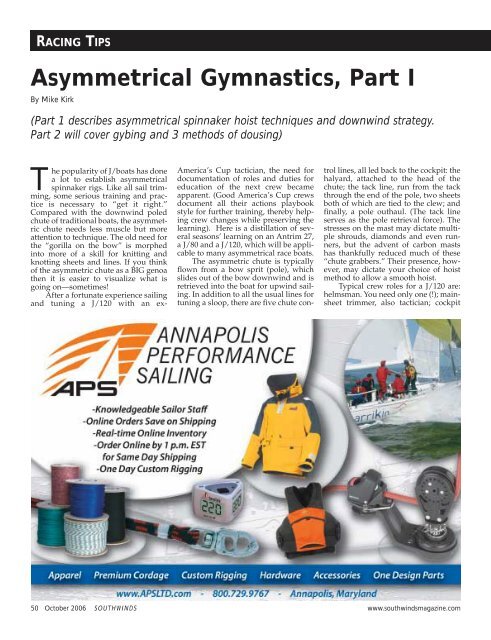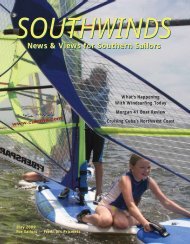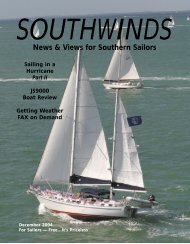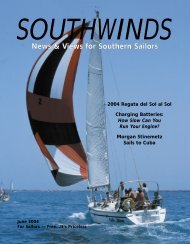News & Views for Southern Sailors - Southwinds Magazine
News & Views for Southern Sailors - Southwinds Magazine
News & Views for Southern Sailors - Southwinds Magazine
- No tags were found...
You also want an ePaper? Increase the reach of your titles
YUMPU automatically turns print PDFs into web optimized ePapers that Google loves.
RACING TIPSAsymmetrical Gymnastics, Part IBy Mike Kirk(Part 1 describes asymmetrical spinnaker hoist techniques and downwind strategy.Part 2 will cover gybing and 3 methods of dousing)The popularity of J/boats has donea lot to establish asymmetricalspinnaker rigs. Like all sail trimming,some serious training and practiceis necessary to “get it right.”Compared with the downwind poledchute of traditional boats, the asymmetricchute needs less muscle but moreattention to technique. The old need <strong>for</strong>the “gorilla on the bow” is morphedinto more of a skill <strong>for</strong> knitting andknotting sheets and lines. If you thinkof the asymmetric chute as a BIG genoathen it is easier to visualize what isgoing on—sometimes!After a <strong>for</strong>tunate experience sailingand tuning a J/120 with an ex-America’s Cup tactician, the need <strong>for</strong>documentation of roles and duties <strong>for</strong>education of the next crew becameapparent. (Good America’s Cup crewsdocument all their actions playbookstyle <strong>for</strong> further training, thereby helpingcrew changes while preserving thelearning). Here is a distillation of severalseasons’ learning on an Antrim 27,a J/80 and a J/120, which will be applicableto many asymmetrical race boats.The asymmetric chute is typicallyflown from a bow sprit (pole), whichslides out of the bow downwind and isretrieved into the boat <strong>for</strong> upwind sailing.In addition to all the usual lines <strong>for</strong>tuning a sloop, there are five chute controllines, all led back to the cockpit: thehalyard, attached to the head of thechute; the tack line, run from the tackthrough the end of the pole, two sheetsboth of which are tied to the clew; andfinally, a pole outhaul. (The tack lineserves as the pole retrieval <strong>for</strong>ce). Thestresses on the mast may dictate multipleshrouds, diamonds and even runners,but the advent of carbon mastshas thankfully reduced much of these“chute grabbers.” Their presence, however,may dictate your choice of hoistmethod to allow a smooth hoist.Typical crew roles <strong>for</strong> a J/120 are:helmsman. You need only one (!); mainsheettrimmer, also tactician; cockpit50 October 2006 SOUTHWINDS www.southwindsmagazine.com
















